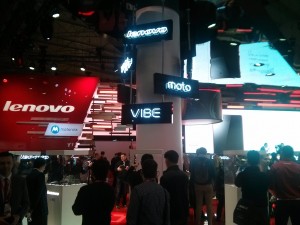CELLPHONES: Lenovo Peddles Moto, Crowds Respond
Bottom line: Lenovo could make significant inroads into western smartphone markets with its newly acquired Motorola if it lets the brand remain independent and maintain its own product development and sales resources.

A tour of the Lenovo (HKEx: 9992) booth at a major trade show happening this week in Spain made me realize just how much the company is betting on its recently purchased Motorola brand to boost it into the smartphone big leagues. Motorola’s continuing attraction as a powerful brand was on full display at the Lenovo booth, with large crowds clamoring for a look at what seemed like quite a ho-hum new low-end model being rolled out at the show.
By comparison, a glitzy new Lenovo-brand model from its higher-end VIBE line was drawing far less attention, even as a Brit on the stage sang on with nonstop praises for the unique features of the new model that has many attributes of a high-end camera.
Somewhat ironically, the new Moto phone that was getting all the attention will sell for a bargain basement starting price of just 90 euros or about $100, the lowest price tag under the current portfolio of Motorola phones. By comparison, the new VIBE Shot that was also making its debut at the Mobile World Congress will sell for a much richer $350 when it launches next quarter.
All of which just goes to show there’s plenty of juice still left in the Motorola name. The big question, of course, is whether Lenovo will quickly exhaust that juice from a storied brand whose name was synonymous with cool, cutting-edge and durable phones during its heyday.
I’m not usually so confident in Lenovo for this kind of task, which even the most seasoned western company like former owner Google (Nasdaq: GOOG) couldn’t pull off. But in this case I’m cautiously optimistic that perhaps the Chinese PC giant could do the impossible and bring back Motorola from the brink of death, allowing Lenovo itself to perhaps one day jettison its own-brand phones that have a decidedly low-brow image.
Unlike many Chinese firms that have embarked on aggressive overseas expansions over the last decade, Lenovo seems like one of the few that are determined to become a truly global company. On searching for the company’s booth location at the conference this week, I was a bit puzzled when it wasn’t present under the listings for the Chinese delegation to the event.
A second search on the company name showed that Lenovo had chosen to list itself as a US company for the show, reflecting a desire not to be seen as just a Chinese firm. Company officials go to lengths to emphasize that their headquarters are in both Beijing and the US state of North Carolina, which was the former home to IBM’s PC business that became the foundation for Lenovo’s global expansion in 2005.
Despite my intense skepticism at that time, Lenovo managed to overcome a number of difficulties, including a painful restructuring not long after the IBM acquisition. I’m also constantly skeptical of the company’s huge appetite for acquisitions of just about any famous brands, including many like Motorola that have fallen on difficult times. But again, Lenovo always seems to find a way to keep going forward and even profiting after taking on these many difficult purchases.
I still think Lenovo has too many PC brands, following acquisitions in such diverse places as Germany, Brazil and Japan in recent years, in addition to its original purchase of the IBM Thinkpad business. What’s more, its core Lenovo PC brand doesn’t really enjoy a very premium image right now, even though I now personally use one of their Yoga computers.
The situation is a little better in smartphones, since Lenovo has been in the business for less time and has only made one major acquisition in the space, Motorola. With that deal, Lenovo has more clearly defined a two-pronged smartphone strategy that will focus on emerging markets with its own brand name, and and developed markets with Motorola. That looks like a smart division for now, and could eventually serve as a template for Lenovo’s older PC business which is fast fading into obscurity anyhow.
Related posts:
